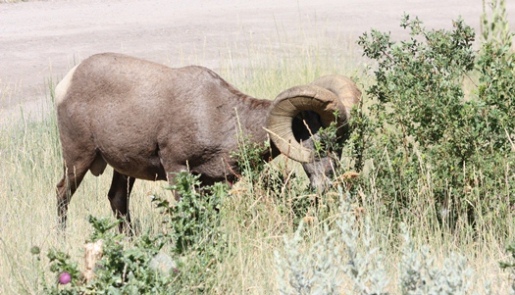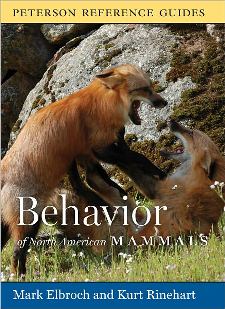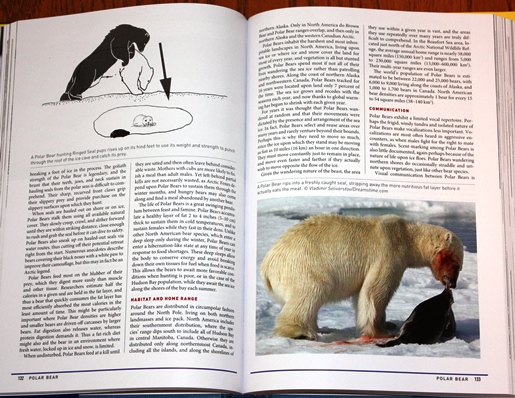Reviewed by Grant McCreary on October 14th, 2013.
On a recent trip to Glacier National Park, my wife and I first stopped at the National Bison Range. We saw the obligatory Bison, as well as other mammals and a few birds. But the stars of the refuge were the Bighorn Sheep. We came upon 30 of them, mostly adult males, right beside the road. What magnificent creatures! As we watched and photographed one browsing on a bush, not even ten feet away, we noticed something curious – it repeatedly head-butted the bush. That’s what it looked like, but we had no idea why it would do so.

Why is this Bighorn Sheep head-butting a bush?
I was not planning to review Peterson Reference Guide to the Behavior of North American Mammals. Not that I don’t like it; on the contrary, I think it’s awesome. But this is the Birder’s Library. However, I’ve found this book to be so consistently useful that I feel compelled to review it here. Finding the likely answer to what that sheep in Montana was doing (scent marking) is just the latest example of something I’ve looked up using this book. It’s amazed me how many times I’ve picked up this book to find the answer to some question.
Behavior of North American Mammals contains 51 accounts, each covering a single species, a pair of related mammals (i.e. “Fisher and American Marten”), or a group of mammals with a focus on one in particular (“Meadow Voles and Allies”). Altogether, more than 70 species are included. The guide focuses on animals that are most likely to be encountered, and seen from land. So while West Indian Manatee, Sea Otter, Walrus, and Northern Elephant Seal are here, cetaceans and other marine mammals are not.
Each account, averaging six-and-a-half pages apiece, includes:
- Introduction – some interesting information or facts not covered elsewhere
- Activity and Movement – both daily and seasonal
- Food and Foraging
- Habitat and Home Range
- Communication
- Courtship and Mating
- Development and Dispersal of Young
- Interactions Among the Species
- Interactions With Other Species
The text is written at an appropriate level for the book’s audience – not too technical, but not dumbed down, either. It’s not a book you’ll read for fun, but not a chore to get through when you’re trying to look something up.
This is not an identification guide, so don’t expect copious illustrations that will help you tell mammals apart. But it does have two or more color photographs per account, along with (rather basic) ink and line drawings. It’s a fun book to flip through; each illustration serves to demonstrate interesting behavior and there are some really cool shots, such as a Red-breasted Sapsucker defending its sap wells from a Douglas’s Squirrel (naturally, I gravitated to a photo that included a bird!).
The only issues I’ve had with Behavior of North American Mammals is with things that are not here. First, I tried to lookup something about Caribou only to find that they aren’t included. However, they aren’t a mammal that people see all that often, so I understand why they were excluded. So I just want to reiterate that this is not an exhaustive reference, but it will cover the vast majority of any questions you have about land mammals.
The second issue is that there are no range maps. Ranges are usually described to a general extent in the text, but I regularly found myself wishing for a map. This isn’t a deal breaker, as if you are using this book the odds are very good you already own a mammal field guide with maps. But species and family range maps would have been greatly appreciated.
Recommendation
Peterson Reference Guide to the Behavior of North American Mammals is essential to anyone who enjoys watching mammals. I would also highly recommend it to birders and others whose primary interest in nature is something other than mammals. Aside from the fact that mammal behavior is a fascinating subject, this reference guide will help you interpret behaviors that you’re bound to see in the field.
Disclosure: I get a small commission for purchases made through links in this post.
Buy from NHBS
(based in the U.K.)
Disclosure: The item reviewed here was a complementary review copy provided by the publisher. But the opinion expressed here is my own, it has not been influenced in any way.







Comment